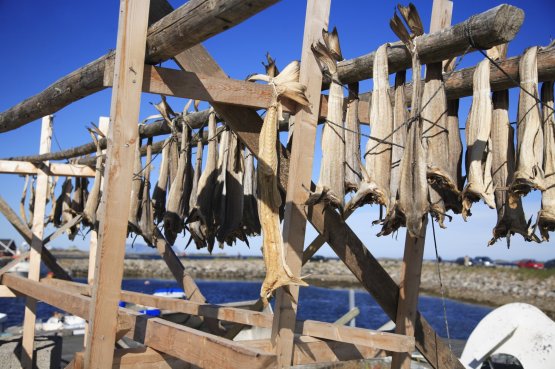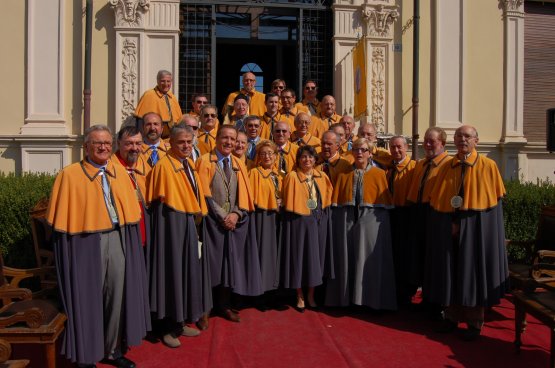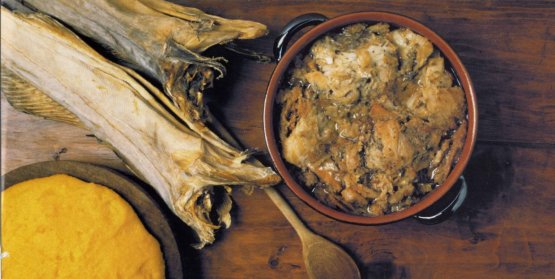«Who knows if we’ll make it for the 30th anniversary of the Confraternita». These days (and until 26th September), the Festa del Bacalà is taking place. Meanwhile, the words of Luciano Righi, president of the confraternity come to my mind. It was the beginning of the summer and we were tasting some salted codfish specialties together in one of its most famous temples, La Trattoria di Palmerino. Established 70 years ago, now in its fourth generation with Antonio Chemello as its chef, it is located in Sandrigo, which hosts the festival and is in a way the capital of this specialty from Vicenza.
«Who knows if we’ll make it for the 30th anniversary of the confraternity», was saying optimist Righi. He’s not a naïf dreamer, but an experienced politician who knows about food (to make it clear, the Confraternita was born in 1987: it will turn 30 next year). Indeed the epopee of salted codfish is at a turning point: the paperwork is ready, the international partnerships already signed… Everything is converging so that the so called Via Querinissima – that is to say the incredible journey which over the centuries has brought the iconic stockfish from the Lofoten Islands to Italy – can soon become a European Cultural Route, a historic-cultural journey acknowledged and safeguarded by the European Council just like the Via Francigena, or the Camino de Santiago, or – the only ones in the food and wine sector, among a total of 32 – the Strada del Vino and that of Olio. Not journeys invented by some local association, but transnational routes that tell the history of food, of Europe and partly our own too.

Stockfish left to dry in the Lofoten Islands
«Last 29th June
Massimo Andreoli [of
Cers, which stands for
Consortium of European Re-Enactment Societies, who supports the
Via del Bacalà project] received a letter from the Norwegian government in which they confirm their support to the project. Plus the coming October the Region of Veneto will meet with the county of Nordland» to ratify the candidacy of the
Via at the European Council, they told us yesterday in Vicenza. An essential turning point: not only because the acknowledgement will make the historical and cultural importance of the
Via Querinissima official, but also because it would grand access to all the European funds that can guarantee an adequate investment for the birth of a real… “tourism on the salted codfish routes”. What are the countries included in this international route? And why is it called
Via Querinissima? In order to answer these questions we must move one step back.
Via Querinissima – In 1431 Venetian merchant Pietro Querini went looking for commercial fortune outside the Mediterranean Sea. Having left Candia (on the island of Crete) with a ship full of Malvasia wine, aromatic wood, spices and cotton with the goal of reaching Flanders, he passed Gibraltar and then moved North and East but then his commercial dream faded because of a tragic shipwreck. He managed to reach a deserted islet, and was saved by the inhabitants of a nearby island. The poor survivors were welcomed, fed and looked after by the local people. These people, 100 km north of the Polar Circle, in today’s Norway, had a strange way of preserving their main food, cod. After cleaning it, salting it and drying it for months, the fish became as hard as a stick. Locals called it “stockfiss”, which by mistake in Veneto they call bacalà (as baccalà, with two c’s is instead cod preserved in salt). The Venetian merchant came home after a long journey by sea and land and brought this strange food, exchanging it on the way to Venice for food, accommodation and various means of transport. After Querini’s return from what we today call Røst, one of the Lofoten Islands, the use of this dried fish became popular in the inland of Venice, especially among the people of Vicenza who considered stockfish a good (and easy to find) alternative to the expensive fresh fish. Even the Catholic church, after the Council of Trent, contributed to the spreading of this new culinary tradition by imposing abstinence.

Group photo with the Confraternita del Bacalà. It was founded in 1987 in Sandrigo (Vicenza) thanks to the initiative of Michele Benetazzo so as to safeguard good local cuisine. Over the years it promoted the study and the research of a codified recipe. It got experts involved to create the right pairings with wine and other local typical products that are more or less suitable for this dish. It created liaisons with other Italian confraternities and promoted the “Italian Norwegian Days” in Sandrigo
- In collaboration with the Nordland and Veneto regions and with the support of the European Consortium for Historic Re-Enactments (
Cers), the project for the
Via Querinissima was designed: it is a historical-cultural route named after “Querini” and “Serenissima”. As mentioned earlier, the
Via retraces the journey taken by noble
Pietro to return to Venice from the Lofoten Islands in 1431 through 14 European countries. The project aims to be included in the
European Cultural Itineraries acknowledged by the
European Council as instruments of communication, cooperation and friendship among European nations and for the economic development, especially in terms of tourism.
The festival – From history and future project to our days. The Festa del Bacalà is back in Sondrigo, until the 26th September. Every year it involves over 35 thousand people for whom 8 tons of bacalà alla vicentina are prepared. This year a special attention is paid to celiacs, with gluten free toasted bread with whipped salted codfish and bacalà alla vicentina, prepared following the traditional recipe but with pieces of stockfish rolled in gluten free flour before being browned. On Sunday and then again from Thursday 22nd to Monday 26th the culinary stands will be at work. You’ll be able to taste the classic bacalà alla vicentina with polenta or dishes made with bacalà. On Sunday 18th September, there was also Bacco&Bacalà, from 2 to 8 p.m. in Villa Sesso Schiavo. The event was organised in collaboration with Ais Veneto presenting wines to be paired with bacalà alla vicentina, from full-bodied white wines to light red wines, including bubbles. This Sunday, 25th September, instead, there will be the investiture ceremony of the new Cavalieri del Bacalà [the Knights of Bacalà]. After the parade with the Culinary Confraternities and the Bacalà Club and the historic re-enactment of the meeting between doge Foscari and captain Pietro Querini, the Prior of the Venerabile Confraternita del Bacalà, Galliano Rosset, will give the festive blessing with a piece of stockfish on the heads of the aspiring members of the Confraternity them. Info:www.baccalaallavicentina.it

In 2009 the European Food International Resource association acknowledged bacalà alla vicentina as one of the five foods representative of Italian tradition in the EuroFIR circuit
– The origin of the recipe for bacalà alla vicentina is rather vague. The
Confraternita del Bacalà today recommends a recipe that results from lengthy study and comparisons between the numerous recipes used in the most famous restaurants and taverns in Vicenza between the 30s and 50s.
BACALA' ALLA VICENTINA
Ingredienti per 12 persone
1 kg dried stockfish
250 g onions
1⁄2 litre non-fruity olive oil
3–4 sardines preserved in salt
1⁄2 litre of fresh milk
a little flour
50 g grated grana padano
1 sprig of parsley
salt
pepper
Method
Beat the stockfish well, soak it in cold water, changing it every 4 hours for 2-3 days. Remove part of the skin. Open the fish lengthwise, remove all the bones. Cut it into square pieces, possibly same-sized. Thinly chop the onions; brown in a pan with a glass of oil, add the sardines having previously desalted, deboned and cut them into pieces; finally, away from the heat, add the chopped parsley. Roll the stockfish pieces in flour, pour the sautéed ingredients on top and place them one next to the other in a casserole tin (first pour some spoons of the sauté on the base of the tin); cover the fish with the rest of the sauté, adding milk, cheese, salt and pepper. Gradually add the oil so as to cover all the pieces, on the same level. Simmer for around 4 and a half hours, moving the tin from time to time without every stirring. The local word for this phase is “pipare”. Only experience will tell you the exact cooking time which can change from piece to piece, in terms of texture. Serve hot with sliced polenta: bacalà alla vicentina is excellent even after it rests 12-14 hours.